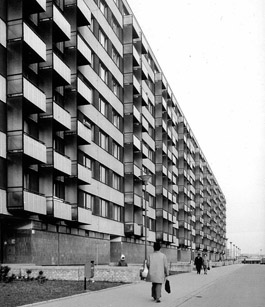
The exhibition focuses on the history, form, and reasons for the emergence of panel houses
 |
The authors of the exhibition also used prefabricated parts in the installation, which form the bases of display cases with exhibits. They emphasize the unique and suffocating sameness, monotony, and stereotype that former residents of panel buildings particularly associate with this type of housing.
The exhibition Residence: Panel Housing Estate - Plans, Implementation, Housing 1945-1989 will last until May 20. According to the authors, it aims to introduce the history of selected housing estates in the Czech Republic and the social, political, cultural, and economic contexts that accompanied their emergence. It is based on a five-year research project that focused on 73 Czech housing estates, mainly from an art-historical perspective, addressing their architecture and urbanism, demographic characteristics of residents, and the possibilities for heritage protection.
Project leader Lucie Skřivánková previously told ČTK that the research showed that not all housing estates are the same; they do not necessarily have to be monotonous clusters of buildings. They have their past, present, and future, and often there is a specific authorial intention behind them. As part of the research, a new periodization of housing estates was created, which is also reflected in the exhibition, with each time period having its own section of the display.
The origins of housing estates are placed back in the 1940s. So-called proto-housing estates were still built using brick technology, but utilized prefabricated elements and principles of functionalist urbanism. Socialist realism in the 1950s brought the first panel buildings with historicizing facades. The pioneering phase (turn of the 1950s and 1960s) was marked by experiments with technologies that led to the first nationally widespread construction systems. In the so-called beautiful phase of the 1960s, the architecturally and urbanistically most successful complexes were created, featuring a wide range of civic amenities and residential qualities of public space, Skřivánková noted.
During the normalization period in the 1970s, architecture was driven by demands for quantity and financial savings. The final phase of postmodernist housing estates (the 1980s) arose from the criticism of the inhumane environment of massive residential complexes from the preceding stage.
A series of lectures is being prepared for the exhibition, which will present specific examples of panel housing estates in more detail, along with workshops for the public and guided tours of the exhibition. More details can be found on the museum's website and project.
The English translation is powered by AI tool. Switch to Czech to view the original text source.
0 comments
add comment
Related articles
0
30.04.2018 | The exhibition about panel houses is being extended, competing for the museum award
0
22.01.2018 | Panel buildings addressed the housing crisis and still attract buyers today due to their price
0
22.01.2018 | The housing estates have their advantages and, according to experts, belong to the history of architecture
0
28.06.2015 | Paneláky - once gray rabbit hutches, now colorful affordable housing
0
23.04.2008 | The main problem of panel houses in the Czech Republic is high thermal losses











